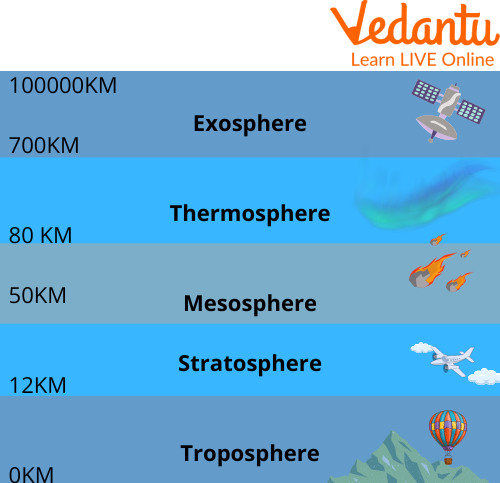




An Overview About Atmosphere
When you stand outside and gaze up, what do you see? Is that a blue sky? A swarm of clouds? You might be wondering, what is the atmosphere? An atmosphere is a layer of gas or layers of gases that envelop a planet and is held in place by the gravity of the planetary body. A planet holds an environment when the gravity is perfect and the temperature of the air is low.
While oxygen is required for most life on Earth, it does not make up the majority of the atmosphere. The Earth's atmosphere is made up of roughly 78% nitrogen, 21% oxygen, 0.9% argon, and 0.1% other gases. Other gases that make up the remaining 0.1 percent include trace amounts of carbon dioxide, methane, water vapour, and neon. In this article, we are going to learn about the atmosphere.

Atmosphere
Atmosphere and Its Layers
An atmosphere is a layer of gas or layers of gases that envelope a planet. One of the main components of Earth's atmosphere is the air. Air is the mixture of gases present on a planet or other heavenly body such as our earth.
Earth's air is made out of around 78% nitrogen, 21% oxygen, and 1% different gases. These gases are trapped in atmospheric layers. The troposphere is the thinnest layer of the atmosphere. The environment safeguards life on earth by protecting it from approaching bright (UV) radiation, keeping the planet warm, and forestalling limits among constant temperatures. Based on temperature, the atmosphere is separated into five different layers.
Troposphere
It is the thinnest layer of the atmosphere which has 80% mass of the air. The climate changes such as heavy rain and lightning happen the most in this part of the layer. Likewise, aeroplanes fly in this layer. Starting from ground level, it extends 10 km in the upward direction above sea level. We live in the troposphere. When we go higher in the troposphere, the temperature gets colder.
Stratosphere
It is the next layer to the troposphere. The Stratosphere reaches out as much as 50 Kilometres above the ground. This layer contains the majority of the ozone gas, which shields us from the UV radiation of the Sun. It contains the ozone layer which protects us from UV radiation which can cause cancer.
Mesosphere
It is the layer above the stratosphere. It reaches upward around 50 kilometres further. The mesosphere has the coldest temperature among all the layers of the environment. The temperature gets colder as you go high up in the mesosphere.
Thermosphere
The layer above the mesosphere is the thermosphere. It is the second highest layer of the atmosphere that absorbs harmful radiation from the Sun. Due to this phenomenon, this layer is also very hot.
Exosphere
The exosphere is the top layer, which merges with what is regarded as outer space. Here, the gravitational pull of Earth is so weak that gas molecules can escape into space. It is the second thinnest layer of the atmosphere after the troposphere.

Atmosphere Information
Ozone Layer
The ozone layer is the layer in the stratosphere that absorbs most of the UV rays. Its chemical formula is O₃. It acts as a shield to the earth.
This layer is gradually depleting because of the use of chlorofluorocarbons. The use of ACs, refrigerators, etc. is becoming a major cause of ozone depletion. Ozone depletion is a major threat to our planet because it can cause glaciers to melt. It also increases the risk of skin cancer due to solar radiation.
Benefits of Atmosphere to Living Beings
The atmosphere protects us from deadly radiation from space and helps to moderate our temperature by preventing sunlight from reaching Earth's surface, which would make things very hot. The atmosphere also traps heat near Earth’s surface, which helps produce pleasant climates. Without an atmosphere, life on Earth could not exist as we know it because then it would be too cold in regions near the poles and too hot at more equatorial latitudes.
Interesting Facts About the Atmosphere
Some of the interesting facts about the atmosphere include the following:
The densest part of the atmosphere only extends to about 20km above the ground. It is a very thin slice compared to the diameter of the Earth, which is 12,472 km.
The atmosphere’s composition has changed over millions of years because of volcanic and microbial activity.
The atmosphere holds the all-important Oxygen that all living organisms need to breathe.
Without the atmosphere protecting us from the Sun’s UV rays, we would have severe sunburns. It also shields us from meteorites and space rocks that come to Earth at high speeds.
Summary
From the above information about the atmosphere, we have learnt that the atmosphere contains greenhouse gases which retain Sun-powered radiation and intensity on our Earth during the evening. We also gained information about different layers of the atmosphere as well as the thinnest and thickest atmospheric layers. We also learned some interesting facts about the atmosphere and how it protects us from Sun-powered harmful radiation. In case of further doubts, read our other article based on this topic.
FAQs on Facts About the Atmosphere
1. How does the atmosphere protect the earth?
The atmosphere covers our Earth like a blanket and protects it from space. It gives valuable pressure on the ground with the goal that we can live easily. Our environment assimilates the intensity from the Sun during the day and holds it for the evening. Subsequently, our evenings don't get excessively cold. The stratosphere in the environment conveys the ozone gas. This gas safeguards living things from disease-causing Ultraviolet beams from the Sun. Our air additionally retains the destructive radiations coming from space. However, we as humans don't regard the climate well overall.
2. How are clouds formed?
Clouds are formed during the condensation of water. The water goes into the environment in the form of water vapour and this water vapour (an invisible gas) gets converted into tiny water droplets which float in the air.
3. What is the difference between ozone depletion and global warming?
Ozone depletion refers to the damage to the ozone layer that surrounds the earth. The damage happens when CFCs come in contact with the ozone, they destroy its molecules. Global warming is the heating of the earth's surface because of greenhouse gases.









